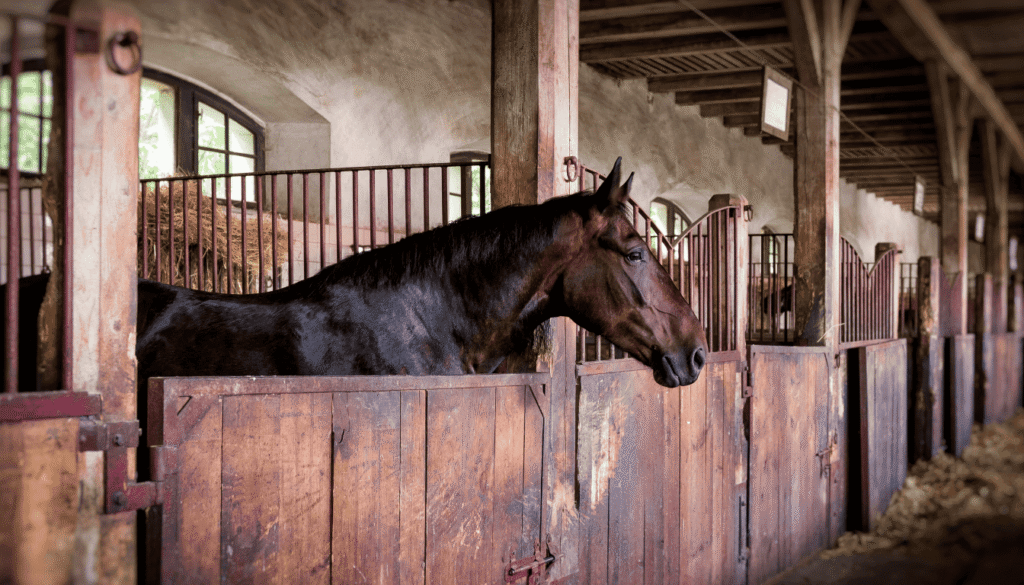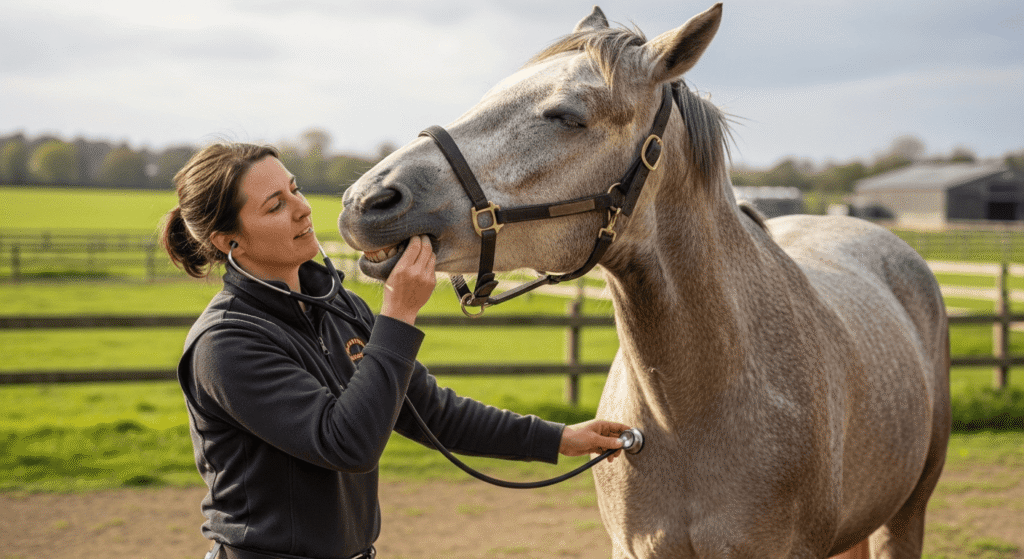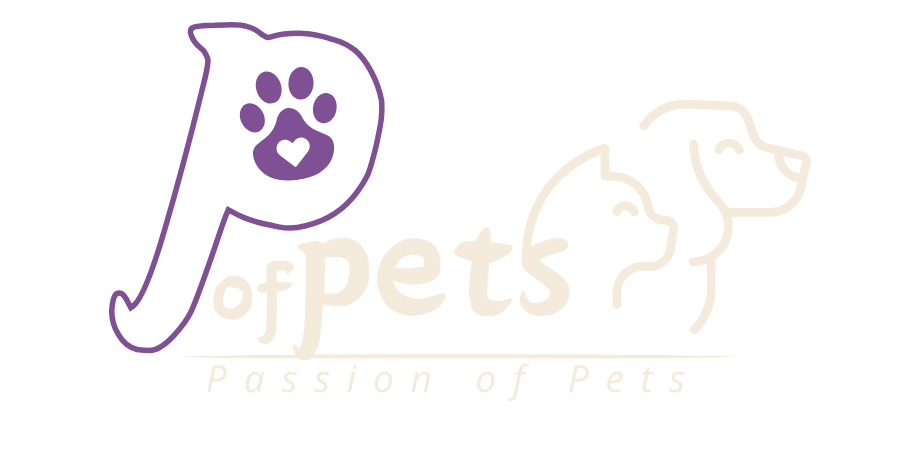Colic is one of the most common and potentially life-threatening conditions horse owners face. Understanding the causes of colic in horses is essential for prevention, early detection, and effective treatment. In this comprehensive guide, we’ll explore the five primary causes of colic, discuss their symptoms, and provide actionable advice to help keep your equine companion healthy and happy.
What Is Colic in Horses?
Colic refers to abdominal pain in horses, often caused by issues in the gastrointestinal tract. It’s not a specific disease but rather a symptom of an underlying problem. The severity of colic can range from mild discomfort to life-threatening conditions requiring immediate veterinary intervention.
Search engines like Google prioritize content that addresses user intent, and in this case, readers are looking for clear, actionable information about the causes of colic in horses. This article will break down each cause, explain its implications, and offer practical solutions.

Cause #1: Impaction Colic
What Is Impaction Colic?
Impaction colic is a specific type of colic that results from the intestines being blocked by partially digested food, compacted fecal material, or other substances. This blockage disrupts the regular passage of ingesta (food and digestive contents) as well as gas through the digestive system.
The obstruction leads to pressure in the intestines, which subsequently may lead to extreme pain, distress, and even life-threatening complications if not addressed.
Horses are particularly susceptible to impaction colic due to their unusual digestive anatomy and reliance on frequent intake of fibrous forage. The horse’s digestive system is adapted for continuous grazing, with a large colon that will take hours to break down cellulose-rich materials.
But any disruption of this delicate balance whether through insufficient watering, poor-quality hay, or reduced exercise may cause the gradual buildup of material within the intestines, ultimately to impaction.
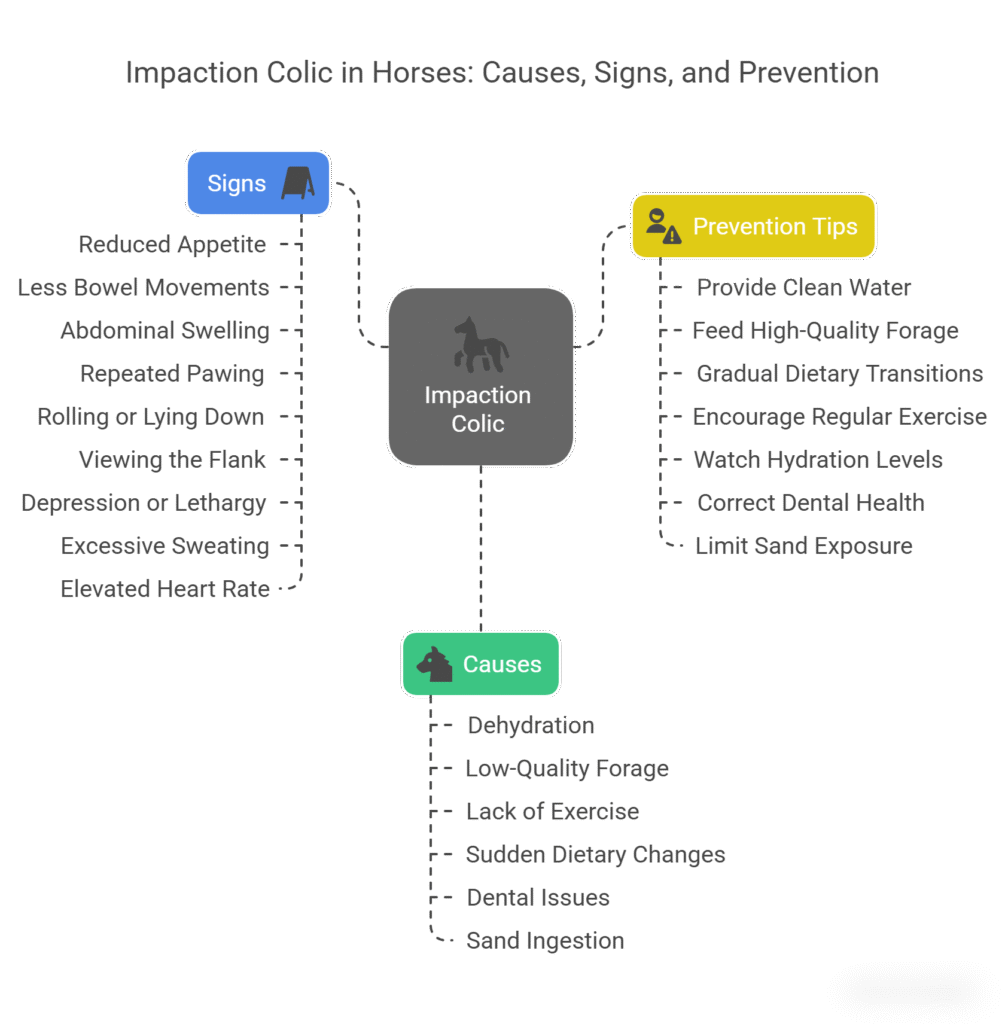
Common Triggers
A number of factors are responsible for the onset of impaction colic. Knowing these causes is essential to avoid the condition and keep your horse healthy.
- 1. Dehydration:
Water is important to maintain the smooth functioning of the digestive system.
When a horse does not drink enough water, its feces dry up and harden, making it more likely to get stuck in the intestines. Dehydration due to extreme weather conditions such as hot summer months or freezing winters when the horse might not get proper water intake is likely. An insufficient supply of clean water sources or disequilibrium of electrolytes with extreme sweating is another cause.
- 2. Low-Quality Forage:
Feeding horses low-quality roughage or hay with low fiber content will hinder effective digestion. The low-quality forage will contain coarse stems, dust, or mold, which the horse’s digestive system will struggle to digest. Over time, the undigested particles will accumulate in the intestines, causing a partial or complete obstruction.
- 3. Lack of Exercise:
Proper movement is essential to enhancing healthy gut motility the coordinated muscle contractions of the intestines that move food through the digestive system. Recumbent horses, especially those stalled for extended periods, experience reduced gut motility and are more prone to impaction. Even limited periods of turnout or gentle exercise significantly improve digestive health and reduce colic risk.
- 4. Sudden Dietary Changes:
Sudden dietary changes in a horse such as a shift from one type of hay to another or introducing new grains—can disrupt the microbial balance of the hindgut. The microbes are what digest fibrous material, and any disruption can impair digestion, contributing to impaction colic.
- 5. Dental Issues:
Tooth problems, such as crooked or sharp-pointing teeth, may interfere with the chewing action of a horse. Incompletely chewed food will not digest adequately enough prior to passing through the digestive system and therefore may have a better chance to produce obstruction.
- 6. Sand Ingestion:
Horses grazing on sandy or dry grasslands may involuntarily ingest sand along with their forage. Sand ingested and entering the intestines can irritate the lining and contribute to forming impactions.
Signs to Observe
Early detection of impaction colic signs can significantly influence treatment. While signs may vary with the severity of impaction, some common indicators are:
- Reduced Appetite: Clear lack of interest in food or refusal to eat altogether.
- Less or No Bowel Movements: Less than usual droppings or failure to produce manure within a few hours.
- Abdominal Swelling or Bloating: Belly distension that can be caused by trapped gas or fluid behind the impaction.
- Repeated Pawing at the Ground: A classic sign of abdominal pain, often accompanied by restlessness or agitation.
- Repetitive Rolling or Lying Down: Attempts to relieve pain by rolling back and forth repeatedly or lying down for extended periods.
- Viewing the Flank: Repeatedly bringing the head forward to look at the flank area, which means discomfort in the abdomen.
- Depression or Lethargy: General signs of malaise like dull eyes, drooping ears, and lethargy.
- Excessive Sweating: Especially at the neck and flanks, showing stress or severe pain.
- Elevated Heart Rate: Elevated heart rate may occur in severe cases of colic because the body is responding to stress and pain.
It is also important to know that not all horses may present all the symptoms, and some may present mild symptoms which may be hard to detect. Regular monitoring of your horse’s feeding, behavior, and dung output can help you catch things early.
Prevention Tips
Prevention of impaction colic entails taking a proactive approach to the way you maintain your horse’s environment, diet, and lifestyle. By curing the causes, you can considerably reduce the chances of this painful condition. Below are some efficient tips:
- Provide Constant Access to Clean Water:
Make sure your horse always has access to fresh, clean water. In cold weather, use heated buckets or trough heaters to keep water from freezing. Feeding electrolytes in your horse’s feed also can stimulate more water intake.
- Feed High-Quality Forage:
Choose high-quality hay or forage that is mold, dust, and weed free. Long-stem fiber is optimal since it triggers chewing and the secretion of saliva, both of which aid in food digestion. Avoid feeding too mature or stemmy hay since it is less digestible.
- Gradual Dietary Transitions:
If you need to change your horse’s feed—for example, from grass hay to alfalfa or introducing new supplements—do it gradually over 7–10 days. This gives the gut microbiome time to transition without upsetting it.
- Encourage Regular Exercise:
Provide ample space for unrestricted movement of your horse. Turnout in a pasture or paddock is ideal, but even light hand-walking or riding can stimulate gut motility and promote digestive health.
- Watch Hydration Levels:
Check your horse’s hydration status periodically by performing a simple skin pinch test. The skin on the neck should spring back quickly if your horse is hydrated. If the skin tents for more than a second, suspect dehydration.
- Correct Dental Health:
Schedule frequent dental checkups with an equine veterinarian to maintain your horse’s teeth in good working order. Properly aligned teeth enable proper chewing, reducing the risk of poorly chewed food reaching the intestines.
- Limit Sand Exposure:
If your horse is feeding on sandy pastures, feed hay in a feeder or rubber mat to minimize sand consumption. Use psyllium supplements to flush out retained sand from the digestive tract.
By taking these preventive measures, you can give your horse a safer and healthier environment and help minimize the risk of impaction colic.
Cause #2: Gas Colic
What Is Gas Colic?
Gas colic is caused by an overproduction of gas in the intestines of the horse, leading to distension, discomfort, and pain. Contrary to impaction colic, with physical blockages, gas colic is the result of excess fermentation in the digestive system. This fermentation creates high levels of gas that the horse has difficulty expelling, putting pressure on intestinal walls.
While gas colic is often less severe than other forms of colic, it is very uncomfortable and has the potential to become more complicated if left undiagnosed. The digestive system of horses is highly sensitive, and even minor imbalances such as diet variation, stress, or overindulgence can trigger excessive gas production.
Gas colic is particularly common in horses because of their characteristic hindgut fermentation process in which bacteria degrade fibrous content. When the process is altered, it tends to lead to a buildup of gases like carbon dioxide and methane.
Common Triggers
Understanding what causes gas colic is the beginning of prevention. Among the most prevalent offenders that disrupt the horse’s delicate balance of digestion are:
- Fermentable Carbohydrates:
Grain, sweet feeds, or lush pasture grasses with high concentrations of fermentable carbohydrates can overburden the digestive system. These carbohydrates are rapidly fermented by microbes in the hindgut, and their byproduct is a large quantity of gas. Examples include sudden access to luxurious spring grass or overfeeding of grain concentrate.
- Stress:
Horses are highly sensitive to what occurs around them, and stress has a considerable influence on their digestive health. Operations such as transport, competition, abrupt changes in routine, or exposure to new environments can disrupt the balance of gut flora. Stress hormones like cortisol also interfere with gut motility, and it becomes harder for the horse to pass gas naturally.
- Overeating:
Consuming big feeds in a hurry can overwhelm the digestive system, especially if the feed contains extremely fermentable ingredients. This is particularly dangerous in horses that are continuously fed or horses that would rather gorge on grain. Bingeing is more stressful for the digestive system and accelerates gas formation.
- Inadequate Forage Intake:
Forage is also important in ensuring good gut function. Without enough fiber, the bulk to stimulate gut motility can be decreased, causing slower digestion and more gas production.
- Sudden Dietary Changes:
Abrupt alterations in a horse’s diet, including switching from hay to fresh grass or supplementing, can disrupt the microbial population in the hindgut. This disruption will typically result in excessive fermentation and gas production.
- Parasites:
Internal parasites such as roundworms or tapeworms can irritate the intestinal lining and interfere with proper digestion. The irritation can also cause spasms, inflammation, and gas buildup.
Symptoms to Watch For

Gas colic generally has symptoms of pain and restlessness in the abdomen. Since horses cannot vomit to remove excess gas, they need to rely on other behaviors to alleviate pain. If you catch these signs early on, you can step in before the condition worsens. The typical indicators are:
- Frequent Rolling or Thrashing:
Horses can roll back and forth in an attempt to relieve strain in their abdomen. In more severe cases of colic, they will flail about, which increases the potential for damage.
- Staring at or Biting the Flanks:
A gas colic horse will swivel its head around to its flanks or attempt to bite the flank, indicating localized pain.
- Restlessness and Pacing: Instead of remaining still, engaged horses will pace back and forth, lie down, get up, and then repeat the process again in an attempt to obtain relief.
- Loud Gut Sounds (Borborygmi):
Excessive rumbling or gurgling sounds emitted from the abdomen are a characteristic feature of gas colic. They are caused by movement of gas through the intestines.
- Bloating:
Visible distension or swelling of the abdomen can be observed, especially along the left side of the horse.
- Sweating:
Horses experiencing severe pain tend to sweat a lot, especially in regions like the neck, shoulders, and flanks.
- Increased Heart Rate and Respiration: Pain and stress related to gas colic can lead to increased heart rate and respirations. Monitoring these key signs can provide additional clues about the horse’s status.
It should be noted that, while gas colic is normally less severe than other types of colic, in extreme cases, it can turn into more perilous situations, such as torsion or displacement of the intestine. Veterinary treatment should be obtained immediately if the signs are severe or persistent.
Prevention Tips
Avoiding gas colic requires control of your horse’s diet, surroundings, and general health. By eliminating possible triggers, you can reduce the occurrence of this uncomfortable condition. Try these effective techniques:
- Restrict Access to Nutritious Pastures:
Acclimate horses gradually to lush pastures, particularly during seasons when there is high grass growth, such as spring. Use grazing muzzles or restrict turnout time to prevent excessive intake of fermentable carbohydrates.
- Gradually Introduce New Feeds:
All dietary adjustments should be gradually introduced over 7–10 days. This allows the gut microbiome to adjust without causing disturbances that might result in overproduction of gas.
- Provide a Stress-Free Environment:
Minimize stressors by maintaining a daily routine. Give your horse a predictable and relaxed environment, either at home or on the road. If shipping or showing your horse, minimize anxiety by giving familiar bedding or companionship.
- Use Slow-Feeders:
Slow-feed hay nets or feeders can be used to help control intake and prevent overeating. These will mimic grazing patterns and encourage slower, more regulated forage intake.
- Offer Adequate Forage:
Offer your horse access to plenty of high-quality forage at all times, such as hay or pasture. Fiber diets aid in beneficial gut motility and maintain a healthy environment for healthy microbes.
6. Avoid Overfeeding Grains:
Limit the amount of grain feeds and switch to alternatives like beet pulp or lower fermentable carbohydrate-containing complete feeds. Fragment grain meals into small amounts given multiple times a day rather than one or two large meals.
7. Regular Deworming:
Implement a strategic deworming regimen based on fecal egg counts to control internal parasites. Develop a plan with your veterinarian to tailor for your horse’s needs and local parasite threats.
- Promote Movement:
Exercise and turnout daily help promote healthy digestion and reduce the likelihood of gas buildup. Even the slightest exercise, such as hand-walking, will encourage the motility of the gut and allow gas expulsion.
Cause #3: Sand Colic
What Is Sand Colic?
Sand colic is an instance of colic induced by horses consuming sand, dirt, or dust-like soil particles in addition to their food. The particles accumulate in the intestines—most commonly in the large colon—and induce irritation, inflammation, or physical blockage. This, in the long term, can hamper normal operations of the digestive system, inducing pain as well as severe consequences.
Horses will automatically tend to graze close to the ground, thus increasing their chances of swallowing sand, especially in areas where food is limited or where feeding habits unknowingly expose them to sandy patches. Even though tiny quantities of sand may go harmlessly through the system, regular intake can result in serious health complications.
The deposited sand’s weight can irritate the intestines’ lining, leading to diarrhea, malabsorption of nutrients, and weight loss. In more severe cases, the sand collects in solid clumps that can obstruct the intestines, and treatment might require medical attention or even surgery to repair.
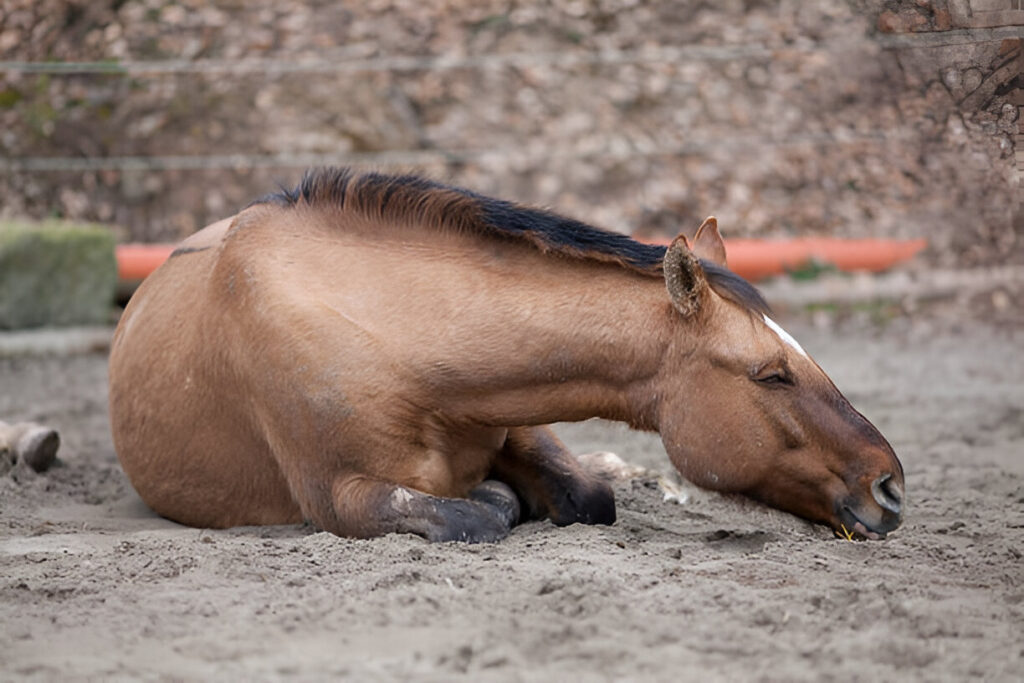
Triggers
Some triggers result in the consumption of sand and ultimately sand colic. These triggers can assist in lowering the risks:
- Ground Feeding:
Horses fed hay, grain, or supplements on sandy or dusty ground are highly likely to ingest sand along with their food. Even if the food appears clean, small pieces of sand can stick to it and be ingested during eating. - Inadequate Grazing Conditions:
Open grasslands with minimal grass cover force horses to graze near the ground level, encouraging the intake of sand or earth. This is particularly dangerous in dry or desert regions where grass coverage is poor. - Environmental Factors:
Wind, rain, or overgrazing erosion can expose sandy soil so that horses can more easily ingest sand while grazing or browsing or sandy turnout or exercise arenas or paddocks, which can cause ingestion of sand. - Behavioral Habits:
Some horses have the tendency to greedily graze or “vacuum” feed off the ground, increasing the chances of ingesting sand. Others graze on the ground out of habit or because they are bored, again increasing the risk. - Poor Feeding Techniques:
In not providing levels of upper feeding or in not monitoring grazing surfaces for sand exposure, horses may be incidentally exposed to toxic intake levels of sand.
Things to Look Out For
Sand colic is likely to present with mild symptoms that could develop over the long term. Early identification of these symptoms will go a long way in preventing further complicated occurrences. Such telltale signs are:
- Chronic Loose Stools or Diarrhea:
Sand in the intestines may cause inflammation of the gut lining, leading to chronic loose stools or diarrhea. You may also notice sand particles in your horse’s feces. - Weight Loss Despite Proper Nutrition:
Sand colic can block the proper absorption of nutrients, causing weight loss regardless of the sufficient calorie and nutrient intake of the horse. - Irregular Attacks of Mild Colic:
Horses with sand colic may experience repeated attacks of mild colic. The attacks could subside for a period but then return unless the underlying cause is addressed. - Dull Coat or Poor Condition:
Nutritional deficiencies due to impaired digestion may also result in a dull coat, lethargy, or a general decline in the horse’s condition. - Decreased Appetite:
Pain or discomfort within the digestive tract may result in decreased intake of food, contributing to weight loss and below-par performance. - Abnormal Gut Sounds:
Auscultation of the abdomen of your horse with a stethoscope may detect changes in gut motility, such as diminished or abnormal sounds, indicative of digestive abnormalities.
Sand colic that goes untreated may progress to more severe complications, including impaction, intestinal rupture, or peritonitis (inflammation of the abdominal cavity). Prompt diagnosis and treatment are essential to avoid these complications.
Prevention Tips
Prevention of sand colic involves good proactive management of your horse’s diet and environment. By eliminating the reasons behind sand ingestion, you can significantly reduce the risk of this painful condition. Some easy tips include:
- Feed Horses in Elevated Troughs or Buckets:
Do not place food directly on the ground, especially in sandy or dusty pastures. Use elevated feeders, rubber mats, or buckets to hold hay, grain, and supplements up off the ground and away from sand contamination. - Frequently Monitor Pastures for Sand Exposure:
Periodically check grazing grounds for evidence of erosion, reduced grass cover, or excessive exposure to sand. Re-seed pastures as necessary to promote healthy grass growth and reduce the horses’ tendency to graze close to the ground. - Provide Psyllium Supplements:
Psyllium is an all-natural dietary fiber that works to catch sand in the intestines and its elimination from the body through the digestive system. Discuss with your veterinarian the addition of psyllium to your horse’s feed as a preventative, or as part of a treatment plan should sand accumulation be an issue. - Provide Alternative Forage Sources:
In poor grazing areas, supplement your horse’s diet with high-quality hay or other sources of forage to reduce the reliance on sparse pasture grass. This can work to decrease the need for grazing close to the ground. - Encourage Regular Exercise:
Exercise promotes healthy gut motility, which allows sand to pass through the digestive system. Give your horse lots of turnout, hand-walking, or light riding to allow for good digestion. - Monitor Manure for Sand:
Check your horse’s manure every now and then for the visible presence of sand particles. In a quick test, fill a clear glass container with water, add a stool sample, mix, and leave it to settle. Sand settles at the bottom, and that will give you an idea about how much sand your horse ingests. - Rotate Grazing Areas:
Practice rotational grazing to prevent over-grazing of particular pastures and reducing erosion risk. Allowing pastures to rest and recover can preserve a healthy stand of vegetation and limit sand exposure. - Address Behavioral Issues:
If your horse eats the ground or wolfs their food, have a go at giving them toys or slow-feeders to occupy them and keep them away from unwanted behavior.
By having these preventive methods in place, you can increase the safety and health of your horse’s living environment and decrease the risk of sand colic.
Cause #4: Parasitic Infestations
What Are Parasitic Infestations?
Parasitic infestations occur when internal parasites, such as roundworms, tapeworms, and strongyles, invade a horse’s digestive system. These parasites can cause significant damage to the intestines, disrupt nutrient absorption, and lead to serious health issues, including colic. Some parasites attach to the intestinal lining, while others migrate through tissues, causing inflammation, scarring, or blockages.
Horses are particularly vulnerable to parasitic infections because they graze on pasture grasses that may harbor parasite eggs or larvae. Once ingested, these parasites mature and reproduce within the horse’s body, perpetuating the cycle of infection. If left untreated, parasitic infestations can compromise the horse’s overall health, leading to malnutrition, weight loss, and even life-threatening complications.

Common Triggers
Several factors contribute to the prevalence and severity of parasitic infestations in horses. Identifying and addressing these triggers is essential for preventing parasite-related problems:
- Inadequate Deworming Protocols:
Failure to deworm horses regularly or using outdated deworming practices allows parasite populations to grow unchecked. Over time, this can result in heavy infestations that overwhelm the horse’s immune system and digestive tract. - Contaminated Pastures:
Shared grazing areas are hotspots for parasite transmission. Horses naturally shed parasite eggs in their manure, which can contaminate the soil and grass. Other horses grazing in the same area may ingest these eggs, continuing the cycle of infection. - Overcrowded Living Conditions:
High stocking densities in paddocks or pastures increase the likelihood of parasite exposure. The more horses sharing a space, the greater the risk of cross-contamination. - Poor Manure Management:
Allowing manure to accumulate in paddocks or stalls creates an ideal environment for parasite eggs and larvae to thrive. This increases the chances of reinfection and spreads parasites among horses. - Immature or Immunocompromised Horses:
Young horses (such as foals) and those with weakened immune systems are more susceptible to parasitic infections. Their bodies may struggle to fight off large parasite loads, making them especially vulnerable. - Seasonal Factors:
Certain parasites, such as small strongyles, are more active during specific seasons. For example, warm, moist conditions in spring and summer promote the hatching and survival of parasite larvae, increasing the risk of infestation.
Symptoms to Watch For
Parasitic infestations often present with subtle symptoms that worsen over time. Early detection is critical for preventing severe complications. Common signs include:
- Dull Coat and Poor Body Condition:
Parasites interfere with nutrient absorption, leading to a lackluster coat and difficulty maintaining weight despite adequate feeding. - Diarrhea or Constipation:
Digestive disturbances caused by intestinal irritation or blockages may result in loose stools or difficulty passing manure. - Recurrent Colic Episodes:
Parasites can cause spasms, inflammation, or physical obstructions in the intestines, leading to frequent bouts of abdominal pain. - Visible Worms in Feces:
In severe cases, adult worms may be visible in the horse’s manure, indicating a heavy infestation. - Weight Loss Despite Adequate Nutrition:
Malabsorption of nutrients due to damaged intestinal walls can cause unexplained weight loss, even if the horse is consuming plenty of food. - Lethargy and Poor Performance:
Chronic parasitism drains the horse’s energy reserves, resulting in fatigue, reduced stamina, and decreased performance. - Pot Belly Appearance:
Heavy roundworm infestations, particularly in young horses, can cause a distended abdomen, giving the horse a “pot-bellied” appearance. - Anemia or Swollen Legs:
Blood-sucking parasites like bots or certain types of strongyles can cause anemia (low red blood cell count), while others may lead to localized swelling, such as edema in the legs.
If you suspect your horse has a parasitic infestation, consult your veterinarian promptly. Diagnostic tests, such as fecal egg counts, can confirm the presence and severity of parasites, allowing for targeted treatment.
Prevention Tips
Preventing parasitic infestations requires a combination of strategic deworming, environmental management, and good hygiene practices. By addressing the root causes of parasite transmission, you can protect your horse’s health and reduce the risk of colic. Here are some effective strategies:
- Implement a Strategic Deworming Program:
Work with your veterinarian to develop a deworming schedule based on fecal egg counts and individual horse needs. Avoid overusing dewormers, as this can lead to drug resistance. Instead, focus on targeted treatments for horses with high parasite burdens. - Rotate Pastures Regularly:
Practice rotational grazing to break the parasite life cycle. Allow pastures to rest and recover between uses to reduce the buildup of eggs and larvae in the soil. - Remove Manure Promptly:
Clean paddocks, stalls, and turnout areas daily to prevent parasite eggs from contaminating the environment. Composting manure at high temperatures can kill parasite larvae before spreading it back onto fields. - Avoid Overstocking Pastures:
Limit the number of horses grazing in a single area to reduce the risk of contamination. Overcrowding increases the concentration of parasite eggs and larvae in the environment. - Use Feeders and Elevated Troughs:
Prevent sand ingestion and reduce exposure to contaminated surfaces by feeding hay and grain in elevated troughs or buckets rather than directly on the ground. - Quarantine New Horses:
Before introducing new horses to your property, perform fecal egg counts and administer appropriate deworming treatments. This helps prevent the introduction of resistant parasites into your herd. - Monitor Young Horses Closely:
Foals and young horses are highly susceptible to parasitic infections. Establish a proactive deworming program for young stock and monitor them for signs of infestation. - Maintain Good Hygiene Practices:
Wash hands, boots, and equipment after handling manure or working in contaminated areas to minimize the spread of parasites.
By adopting these preventive measures, you can create a safer and healthier environment for your horse while minimizing the risk of parasitic infestations and associated complications like colic.
Cause #5: Changes in Diet
Why Dietary Changes Trigger Colic
Horses’ gastrointestinal systems are extremely sensitive and rely on a highly adjusted balance of gut bacteria in order to break down fiber substances and efficiently utilize nutrients. Dietary alteration leads to a disruption in this environment, resulting in alteration to the hindgut’s microbial population. Such imbalances may produce excess gas, abnormalities of fermentation, or even physical blockages, all of which have the potential to induce colic.
Horses are designed to graze around the clock on constant forage sources, and their digestive systems slowly acclimate to novel foods. Too suddenly offered high-starch grains, rich pastures, or new supplements can overwhelm the gut microflora, leading to fermentation imbalances and gastrointestinal distress. Even relatively subtle changes—such as switching from one type of hay to another—can be risky if not done cautiously.
Common Triggers
A number of dietary change-related factors can cause colic in horses. Being aware of these triggers saves you from unnecessary risks:
- Sudden Introduction of Grains or Supplements:
Overfeeding very high amounts of high-starch grains (oats, corn, or barley) or concentrated foods too quickly will cause fast hindgut fermentation. This produces too much acid and gas buildup irritating the intestines’ lining, increasing colic risk. Tipping the digestive system by feeding new supplements without acclimatization will also upset it. - Seasonal Changes in Forage:
Changing between types of hay—such as changing from grass hay to alfalfa—changing from dry hay to fresh pasturage grass is difficult to do suddenly. Each type of forage has a different blend, and such changes can wreak havoc on gut microbials. - Overfeeding Lush Pasture Grass:
Allowing horses unrestricted access to lush spring pasture following a winter of dry hay can put the digestive system under strain. Grasses contain high levels of fermentable carbohydrates and sugars that may lead to gas buildup or laminitis and colic. - Irregular Feeding Patterns:
Horses thrive on habit, and irregular feeding schedules or skipped meals can put strain on the digestive system. Such inconsistency can impede gut motility, causing it to become harder for the horse to move food and gas through the digestive tract efficiently. - Feeding Spoiled or Moldy Feed:
Eating spoiled hay, grain, or supplements may result in the ingestion of toxic substances in the digestive tract, which irritate the lining of the gut and may lead to colic. - Overconsumption of Treats or Unfamiliar Foods:
Giving large amounts of treats, vegetables, or fruit—especially high-sugar or high-starch items—will upset the digestive balance. Horses will consume toxic plants or other foreign objects when exploring new territories.
Symptoms to Watch For
Dietary colic normally manifests as abdominal discomfort and gastrointestinal upset. Being able to recognize these signs in their initial stages can allow you to act before things get worse. A few of the typical signs are:
- Mild to Moderate Abdominal Pain:
Horses may exhibit symptoms such as pawing the ground, looking at their flanks, or laying down excessively. These are indications of pain resulting from gas buildup, spasms, or other gastrointestinal issues. - Decreased Appetite:
Unwanted loss of appetite or refusal to eat or eat full meals might be an indicator of gastrointestinal upset. Horses suffering from colic lose appetite as their body focuses on adapting to pain and inflammation. - Changes in Stool Consistency:
Diarrhea, constipation, or abnormally dry dung is possible because of interference with the digestive process. Sand grains or undigested food may in some cases be found in the feces. - Swelling or Bloating of the Belly:
Visible protrusion of the belly may occur because of accumulated gas or fluid, both being common complications because of diet change. - Restlessness or Pacing:
Colicky horses can become restless, pacing backwards and forwards, or standing up and lying down repeatedly as they seek relief. - Reduced Gut Sounds:
Auscultation of the horse’s abdomen using a stethoscope may be positive for diminished gut sounds, an indication of decreased motility with potential obstruction.
If symptoms do not subside or become more powerful, have your horse examined by a veterinarian in order to rule out more advanced illnesses.
Prevention Advice
Prevention of diet-based colic comes with careful treatment of your horse’s feeding adjustments and habits. Being consistent while gradually introducing adjustment will help alleviate the risk of digestive upset. Some useful advice is below:
- Transition Diet Over 7–10 Days:
Introduce new feeds, supplements, or forage types slowly by blending them with the current diet in increasing and increasing amounts over a week or longer. This allows the gut microbiome to adapt without causing disruptions. - Observe Your Horse Carefully During Transitions:
Watch your horse’s attitude, appetite, and quality of manure during feeding changes. If there is discomfort or digestive issues, adjust the transition timeline or consult with your veterinarian. - Consult a Veterinarian or Equine Nutritionist:
Before making significant dietary adjustments, seek advice from a professional to ensure the changes are appropriate for your horse’s age, activity level, and health status. They can help tailor a feeding plan to meet your horse’s specific needs. - Limit Access to Rich Pastures:
Use muzzles while grazing or restrict turnout time when introducing horses onto rich spring pastures. Acclimate them gradually over a few weeks to allow the digestive system to adjust. - Avoid Overfeeding Grains or Concentrates:
Divide grain meals into smaller portions fed several times daily rather than one or two large meals. This decreases the risk of overwhelming the digestive system and curbs gas production. - Provide Regular Feeding Regimens:
Stick to scheduled feeding and missing meals as little as possible. Regularity ensures healthy gut motility and avoids stress on the digestive system. - Check Feed for Quality and Freshness:
Always inspect hay, grain, and supplements for spoilage, mold, or contamination prior to feeding. Keep feed in a dry, cool area to maintain its quality. - Give Treats in Moderation:
Give treats in moderation and choose ones that are digestible and safe. Never give new or high-sugar foods that will upset the digestive system.
These preventive measures will keep your horse’s digestive system healthy and reduce the incidence of colic caused by dietary changes.
Preventing Colic in Horses
While understanding the causes of colic in horses is crucial, taking proactive steps to prevent colic is equally important. Here are some general tips to minimize the risk:
- Provide Consistent Care: Stick to a regular feeding, turnout, and exercise schedule.
- Monitor Water Intake: Ensure your horse drinks enough water, especially during hot weather or after strenuous activity.
- Regular Vet Check-Ups: Schedule routine dental exams and wellness visits to catch potential issues early.
- Promote Mental Health: Reduce stress through companionship, enrichment activities, and a calm environment.
Frequently Asked Questions (FAQs)
Q1: How do I know if my horse has colic?
A: Signs include restlessness, pawing, rolling, lack of appetite, and abnormal bowel movements. Contact a vet immediately if you suspect colic.
Q2: Can colic be fatal?
A: Yes, severe cases of colic can be life-threatening if not treated promptly. Surgical intervention may be necessary in some instances.
Q3: Is there a vaccine for colic?
A: While there’s no vaccine specifically for colic, vaccines against diseases like Potomac Horse Fever and clostridial infections can reduce related risks.
Q4: How long does it take to recover from colic?
A: Recovery depends on the type and severity of colic. Mild cases may resolve within hours, while surgical cases require weeks of recovery.
Q5: Can I treat colic at home?
A: Only mild cases should be managed at home under veterinary guidance. Severe cases always require professional care.
Conclusion
Understanding the causes of colic in horses empowers horse owners to take preventive action and respond effectively when problems arise. From impaction and gas colic to parasitic infestations and dietary mismanagement, each cause presents unique challenges—but also opportunities for intervention. By prioritizing hydration, proper nutrition, parasite control, and stress management, you can significantly reduce your horse’s risk of colic.
If you found this article helpful, share it with fellow equestrians who might benefit from this knowledge. And remember, staying informed is the best way to ensure your horse lives a long, healthy, and colic-free life!

Dr.Vala Siddharajsinh Raysinhbhai is a certified Animal Husbandry Technician, holding a diploma from Kamdhenu University, India. His expertise covers livestock breeding, nutrition, disease control, and animal welfare. Passionate about rural veterinary care, he actively contributes to animal health awareness and sustainable livestock management through both fieldwork and educational content.



